Spacer Designs for Improved Hydrodynamics and Filtration Efficiency in Sea Water Reverse Osmosis
Abstract
1. Introduction
2. Materials and Methods
2.1. Numerical Approach
2.2. Geometric Characteristics of Feed Spacers
2.3. Experimental Protocol for RO Tests
3. Results and Discussion
3.1. Localized Flow Field Velocity Distribution
3.2. Spatial Flow Vorticity Distribution
3.3. Localized Salt Concentration Field Simulation
3.4. Localized Mass Transfer Distribution
3.5. Experimental Validation of DNS Simulations in RO Process
4. Conclusions
- The vorticity magnitude distribution map on the membrane surface strongly correlated with those of velocity and salt concentration, with areas of high vorticity coinciding with areas of high velocity and low salt concentration.
- More efficient fluid mixing was achieved by the standard spacer translated by a greater velocity/vorticity magnitude in the middle of spacer cells, resulting in enhanced permeation velocity and mitigated concentration polarization.
- Compared to the commercial spacer, the standard spacer increased permeate and specific flux by 13% in RO tests, demonstrating a more efficient and energy-reduced process when integrated into RO SWM elements.
Author Contributions
Funding
Data Availability Statement
Acknowledgments
Conflicts of Interest
References
- Greenlee, L.F.; Lawler, D.F.; Freeman, B.D.; Marrot, B.; Moulin, P. Reverse osmosis desalination: Water sources, technology, and today’s challenges. Water Res. 2009, 43, 2317–2348. [Google Scholar] [CrossRef]
- Khawaji, A.D.; Kutubkhanah, I.K.; Wie, J.-M. Advances in seawater desalination technologies. Desalination 2008, 221, 47–69. [Google Scholar] [CrossRef]
- Lee, K.P.; Arnot, T.C.; Mattia, D. A review of reverse osmosis membrane materials for desalination—Development to date and future potential. J. Membr. Sci. 2011, 370, 1–22. [Google Scholar] [CrossRef]
- Malaeb, L.; Ayoub, G.M. Reverse osmosis technology for water treatment: State of the art review. Desalination 2011, 267, 1–8. [Google Scholar] [CrossRef]
- Shenvi, S.S.; Isloor, A.M.; Ismail, A.F. A review on RO membrane technology: Developments and challenges. Desalination 2015, 368, 10–26. [Google Scholar] [CrossRef]
- Toh, K.Y.; Liang, Y.Y.; Lau, W.J.; Fimbres Weihs, G.A. 3D CFD study on hydrodynamics and mass transfer phenomena for SWM feed spacer with different floating characteristics. Chem. Eng. Res. Des. 2020, 159, 36–46. [Google Scholar] [CrossRef]
- Li, M. Predictive modeling of a commercial spiral wound seawater reverse osmosis module. Chem. Eng. Res. Des. 2019, 148, 440–450. [Google Scholar] [CrossRef]
- Lim, Y.J.; Goh, K.; Kurihara, M.; Wang, R. Seawater desalination by reverse osmosis: Current development and future challenges in membrane fabrication—A review. J. Membr. Sci. 2021, 629, 119292. [Google Scholar] [CrossRef]
- Ibrahim, Y.; Hilal, N. The potentials of 3D-printed feed spacers in reducing the environmental footprint of membrane separation processes. J. Environ. Chem. Eng. 2023, 11, 109249. [Google Scholar] [CrossRef]
- Han, Z.; Terashima, M.; Liu, B.; Yasui, H. Impact of modified spacer on flow pattern in narrow spacer-filled channels for spiral-wound membrane modules. Environments 2018, 5, 116. [Google Scholar] [CrossRef]
- Sreedhar, N.; Thomas, N.; Ghaffour, N.; Arafat, H.A. The evolution of feed spacer role in membrane applications for desalination and water treatment: A critical review and future perspective. Desalination 2023, 554, 116505. [Google Scholar] [CrossRef]
- Lin, W.-C.; Shao, R.-P.; Wang, X.-M.; Huang, X. Impacts of non-uniform filament feed spacers characteristics on the hydraulic and anti-fouling performances in the spacer-filled membrane channels: Experiment and numerical simulation. Water Res. 2020, 185, 116251. [Google Scholar] [CrossRef]
- Qamar, A.; Kerdi, S.; Ali, S.M.; Shon, H.K.; Vrouwenvelder, J.S.; Ghaffour, N. Novel hole-pillar spacer design for improved hydrodynamics and biofouling mitigation in membrane filtration. Sci. Rep. 2021, 11, 6979. [Google Scholar] [CrossRef] [PubMed]
- Radu, A.I.; van Steen, M.S.H.; Vrouwenvelder, J.S.; van Loosdrecht, M.C.M.; Picioreanu, C. Spacer geometry and particle deposition in spiral wound membrane feed channels. Water Res. 2014, 64, 160–176. [Google Scholar] [CrossRef] [PubMed]
- Siddiqui, A.; Farhat, N.; Bucs, S.S.; Linares, R.V.; Picioreanu, C.; Kruithof, J.C.; van Loosdrecht, M.C.M.; Kidwell, J.; Vrouwenvelder, J.S. Development and characterization of 3D-printed feed spacers for spiral wound membrane systems. Water Res. 2016, 91, 55–67. [Google Scholar] [CrossRef]
- Gu, B.; Adjiman, C.S.; Xu, X.Y. The effect of feed spacer geometry on membrane performance and concentration polarisation based on 3D CFD simulations. J. Membr. Sci. 2017, 527, 78–91. [Google Scholar] [CrossRef]
- Massons-Gassol, G.; Gilabert-Oriol, G.; Johnson, J.; Arrowood, T. Comparing biofouling development in membrane fouling simulators and spiral-wound reverse osmosis elements using river water and municipal wastewater. Ind. Eng. Chem. Res. 2017, 56, 11628–11633. [Google Scholar] [CrossRef]
- Sreedhar, N.; Thomas, N.; Al-Ketan, O.; Rowshan, R.; Hernandez, H.; Abu Al-Rub, R.K.; Arafat, H.A. 3D printed feed spacers based on triply periodic minimal surfaces for flux enhancement and biofouling mitigation in RO and UF. Desalination 2018, 425, 12–21. [Google Scholar] [CrossRef]
- Sreedhar, N.; Thomas, N.; Al-Ketan, O.; Rowshan, R.; Abu Al-Rub, R.K.; Hong, S.; Arafat, H.A. Impacts of feed spacer design on UF membrane cleaning efficiency. J. Membr. Sci. 2020, 616, 118571. [Google Scholar] [CrossRef]
- Park, S.; Jeong, Y.D.; Lee, J.H.; Kim, J.; Jeong, K.; Cho, K.H. 3D printed honeycomb-shaped feed channel spacer for membrane fouling mitigation in nanofiltration. J. Membr. Sci. 2021, 620, 118665. [Google Scholar] [CrossRef]
- Kerdi, S.; Qamar, A.; Vrouwenvelder, J.S.; Ghaffour, N. Fouling resilient perforated feed spacers for membrane filtration. Water Res. 2018, 140, 211–219. [Google Scholar] [CrossRef]
- Chong, Y.K.; Liang, Y.Y.; Lau, W.J.; Fimbres Weihs, G.A. 3D CFD study of hydrodynamics and mass transfer phenomena for spiral wound membrane submerged-type feed spacer with different node geometries and sizes. Int. J. Heat Mass Transf. 2022, 191, 122819. [Google Scholar] [CrossRef]
- Kerdi, S.; Qamar, A.; Vrouwenvelder, J.S.; Ghaffour, N. Effect of localized hydrodynamics on biofilm attachment and growth in a cross-flow filtration channel. Water Res. 2021, 188, 116502. [Google Scholar] [CrossRef] [PubMed]
- Ahmad, A.L.; Lau, K.K.; Bakar, M.Z.A.; Shukor, S.R.A. Integrated CFD simulation of concentration polarization in narrow membrane channel. Comput. Chem. Eng. 2005, 29, 2087–2095. [Google Scholar] [CrossRef]
- Zhou, Z.; Ling, B.; Battiato, I.; Husson, S.M.; Ladner, D.A. Concentration polarization over reverse osmosis membranes with engineered surface features. J. Membr. Sci. 2021, 617, 118199. [Google Scholar] [CrossRef]
- Geraldes, V.; Afonso, M.D. Prediction of the concentration polarization in the nanofiltration/reverse osmosis of dilute multi-ionic solutions. J. Membr. Sci. 2007, 300, 20–27. [Google Scholar] [CrossRef]
- ANSYS. ANSYS Fluent 2022 R1; Southpointe: Delta, BC, Canada; ANSYS, Inc.: Canonburg, PA, USA, 2022. [Google Scholar]
- Qamar, A.; Hasan, N.; Sanghi, S. A new spatial discretization strategy of the convective flux term for the hyperbolic conservation laws. Eng. Appl. Comput. Fluid Mech. 2010, 4, 593–611. [Google Scholar] [CrossRef]
- KAUST Supercomputing Laboratory. Available online: https://docs.hpc.kaust.edu.sa/quickstart/index.html (accessed on 17 May 2024).
- Alpatova, A.; Alsaadi, A.; Ghaffour, N. Boron evaporation in thermally-driven seawater desalination: Effect of temperature and operating conditions. J. Hazard. Mater. 2018, 351, 224–231. [Google Scholar] [CrossRef] [PubMed]
- Abid, H.S.; Johnson, D.J.; Hashaikeh, R.; Hilal, N. A review of efforts to reduce membrane fouling by control of feed spacer characteristics. Desalination 2017, 420, 384–402. [Google Scholar] [CrossRef]
- Rahmawati, R.; Bilad, M.R.; Nawi, N.I.M.; Wibisono, Y.; Suhaimi, H.; Shamsuddin, N.; Arahman, N. Engineered spacers for fouling mitigation in pressure driven membrane processes: Progress and projection. J. Environ. Chem. Eng. 2021, 9, 106285. [Google Scholar] [CrossRef]
- Gimmelshtein, M.; Semiat, R. Investigation of flow next to membrane walls. J. Membr. Sci. 2005, 264, 137–150. [Google Scholar] [CrossRef]
- Jeong, Y.-H.; Jeong, S.; Jeong, S.; Gu, B. Helical strip-type spacers for enhanced multi-directional mixing and mitigation of temperature polarisation in membrane distillation—A numerical and experimental investigation. J. Membr. Sci. 2024, 707, 122987. [Google Scholar] [CrossRef]
- Qi, P.; Li, X.; Li, X.; Qiao, S.; Tan, S.; Du, S.; Chen, Y. Experimental investigation of the turbulent flow in a rod bundle channel with spacer grids. Ann. Nucl. Energy 2019, 130, 142–156. [Google Scholar] [CrossRef]
- Qamar, A.; Bucs, S.; Picioreanu, C.; Vrouwenvelder, J.; Ghaffour, N. Hydrodynamic flow transition dynamics in a spacer filled filtration channel using direct numerical simulation. J. Membr. Sci. 2019, 590, 117264. [Google Scholar] [CrossRef]
- Anqi, A.E.; Alkhamis, N.; Oztekin, A. Computational study of desalination by reverse osmosis—Three-dimensional analyses. Desalination 2016, 388, 38–49. [Google Scholar] [CrossRef]
- Horstmeyer, N.; Lippert, T.; Schön, D.; Schlederer, F.; Picioreanu, C.; Achterhold, K.; Pfeiffer, F.; Drewes, J.E. CT scanning of membrane feed spacers—Impact of spacer model accuracy on hydrodynamic and solute transport modeling in membrane feed channels. J. Membr. Sci. 2018, 564, 133–145. [Google Scholar] [CrossRef]
- Ahmad, A.L.; Lau, K.K.; Abu Bakar, M.Z. Impact of different spacer filament geometries on concentration polarization control in narrow membrane channel. J. Membr. Sci. 2005, 262, 138–152. [Google Scholar] [CrossRef]
- Bae, S.; Gu, B.; Lee, J.H. A 3D CFD study on the effects of feed spacer designs on membrane performance for high-permeance RO membranes. J. Water Process Eng. 2023, 53, 103887. [Google Scholar] [CrossRef]
- Lou, J.; Johnston, J.; Cath, T.Y.; Martinand, D.; Tilton, N. Computational fluid dynamics simulations of unsteady mixing in spacer-filled direct contact membrane distillation channels. J. Membr. Sci. 2021, 622, 118931. [Google Scholar] [CrossRef]
- Elsayed-Ali, H.E. Elevation-distributed multistage reverse osmosis desalination with seawater pumped storage. Appl. Water Sci. 2022, 13, 48. [Google Scholar] [CrossRef]
- Qian, X.; Anvari, A.; Hoek, E.M.V.; McCutcheon, J.R. Advancements in conventional and 3D printed feed spacers in membrane modules. Desalination 2023, 556, 116518. [Google Scholar] [CrossRef]
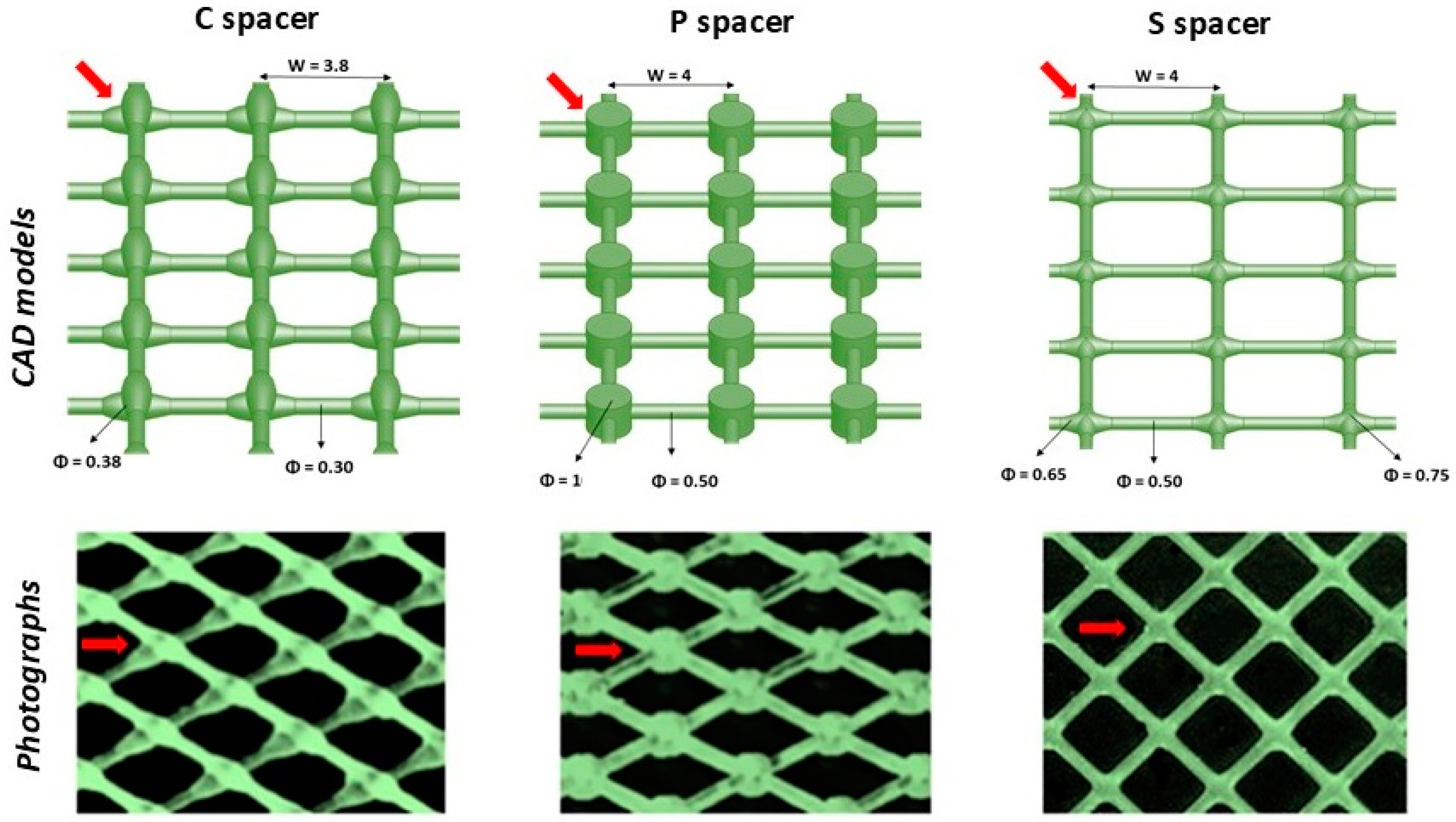
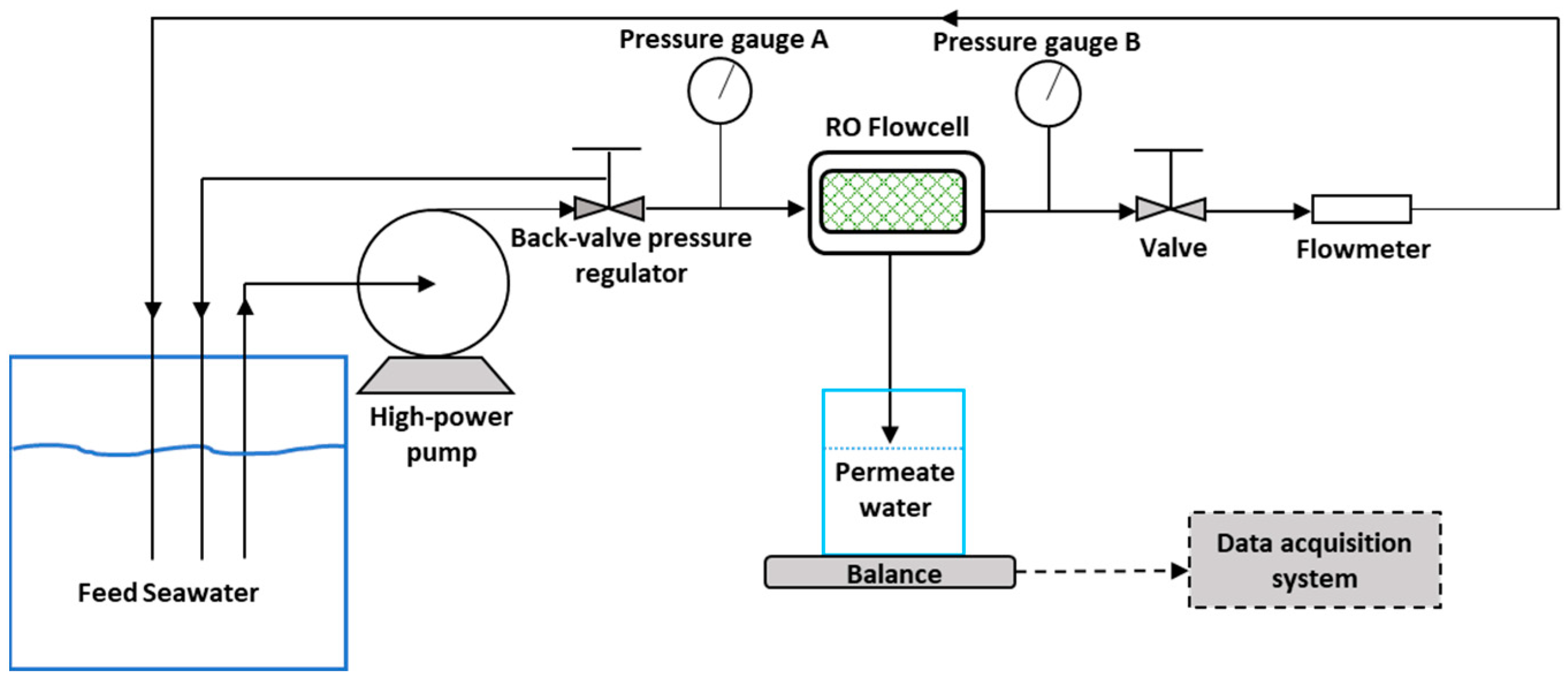
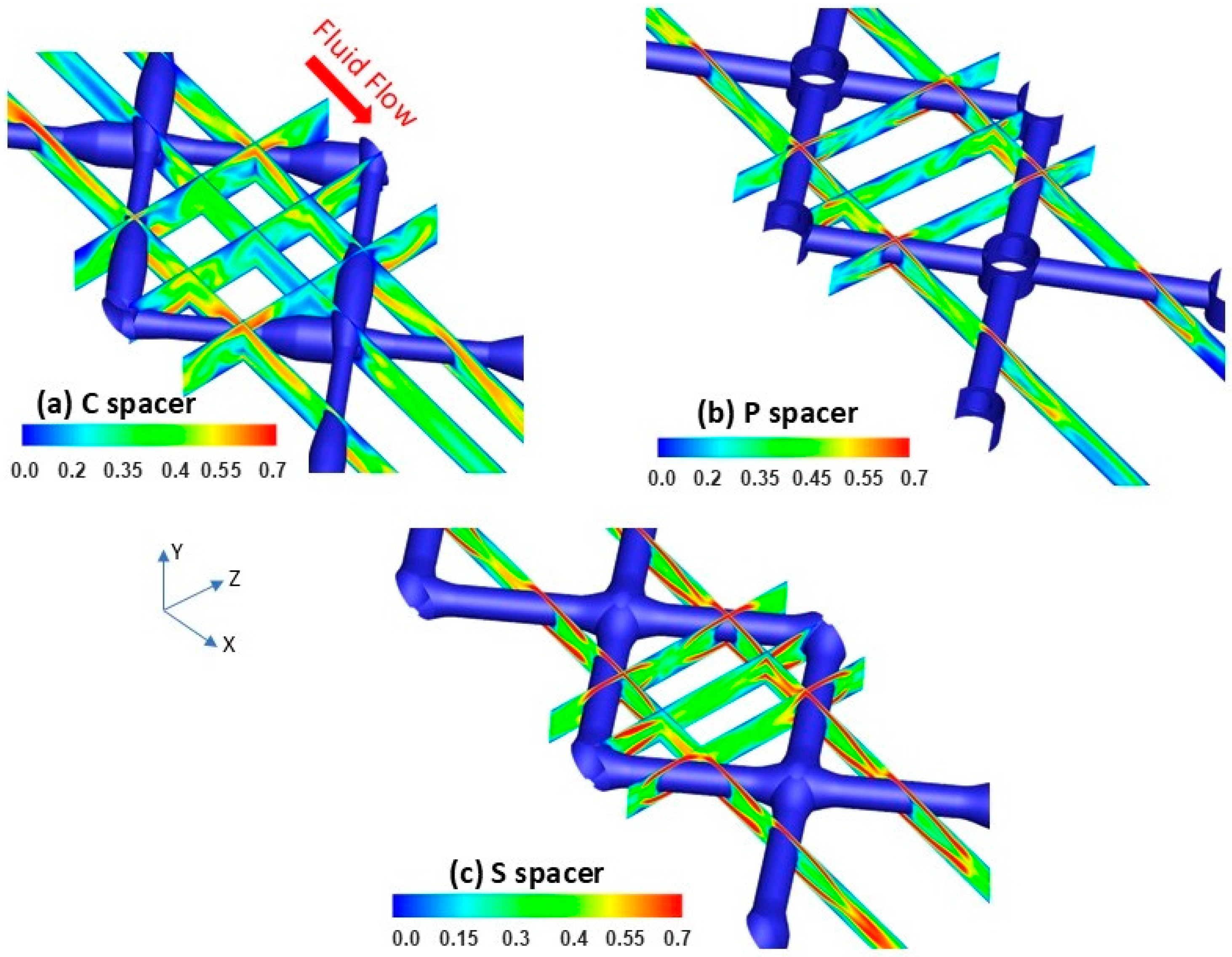
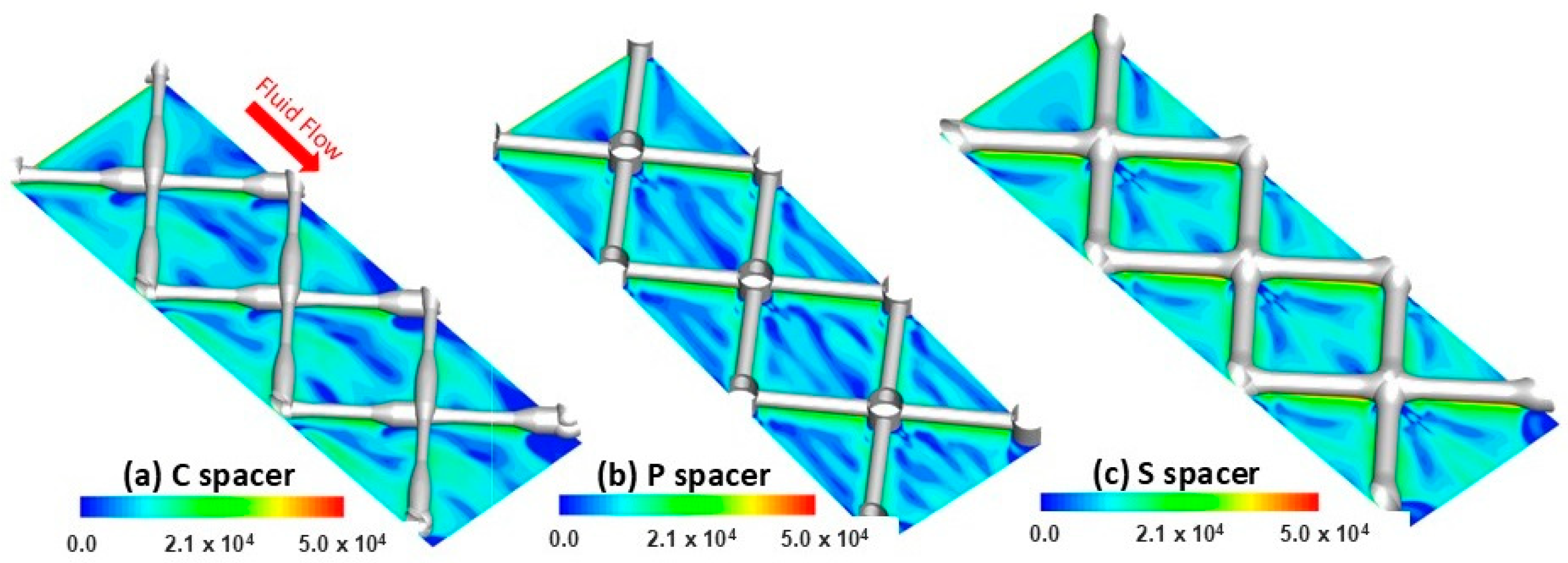

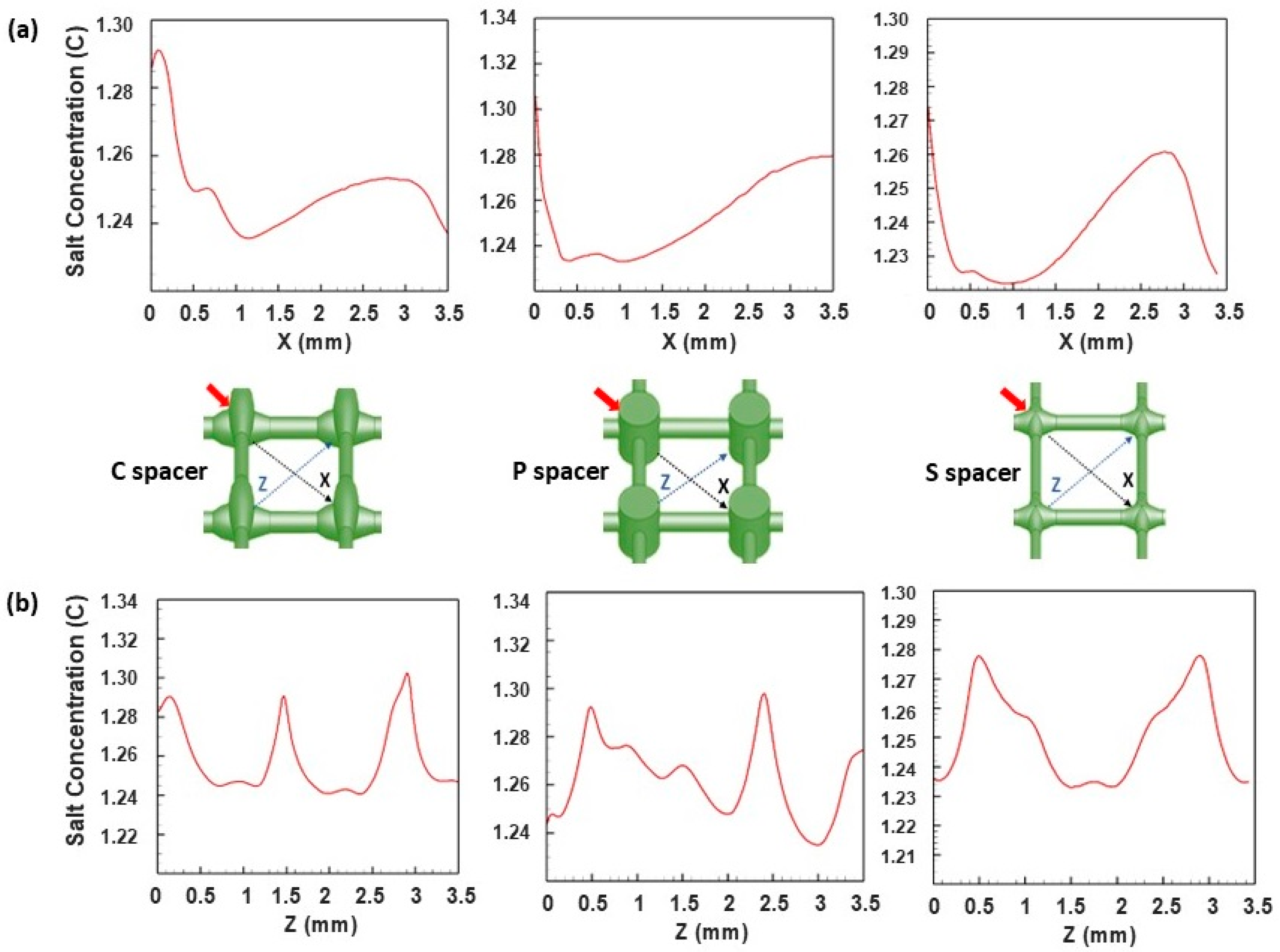
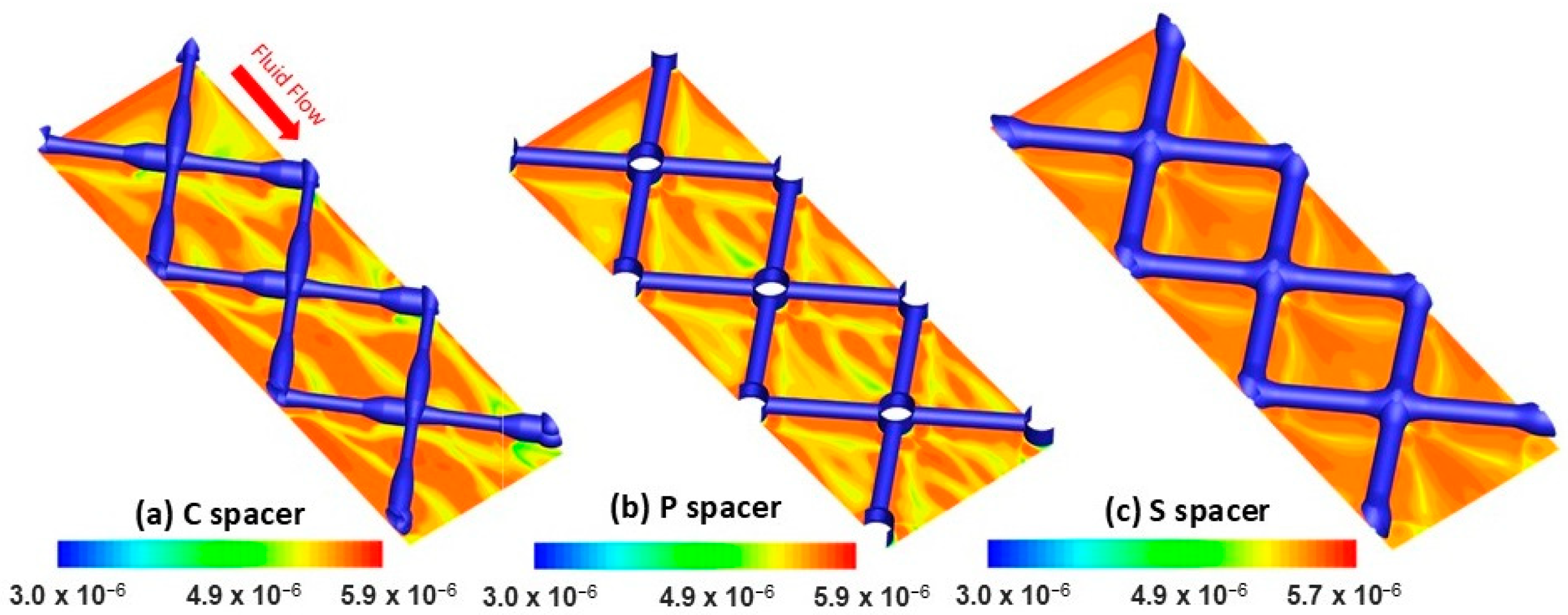
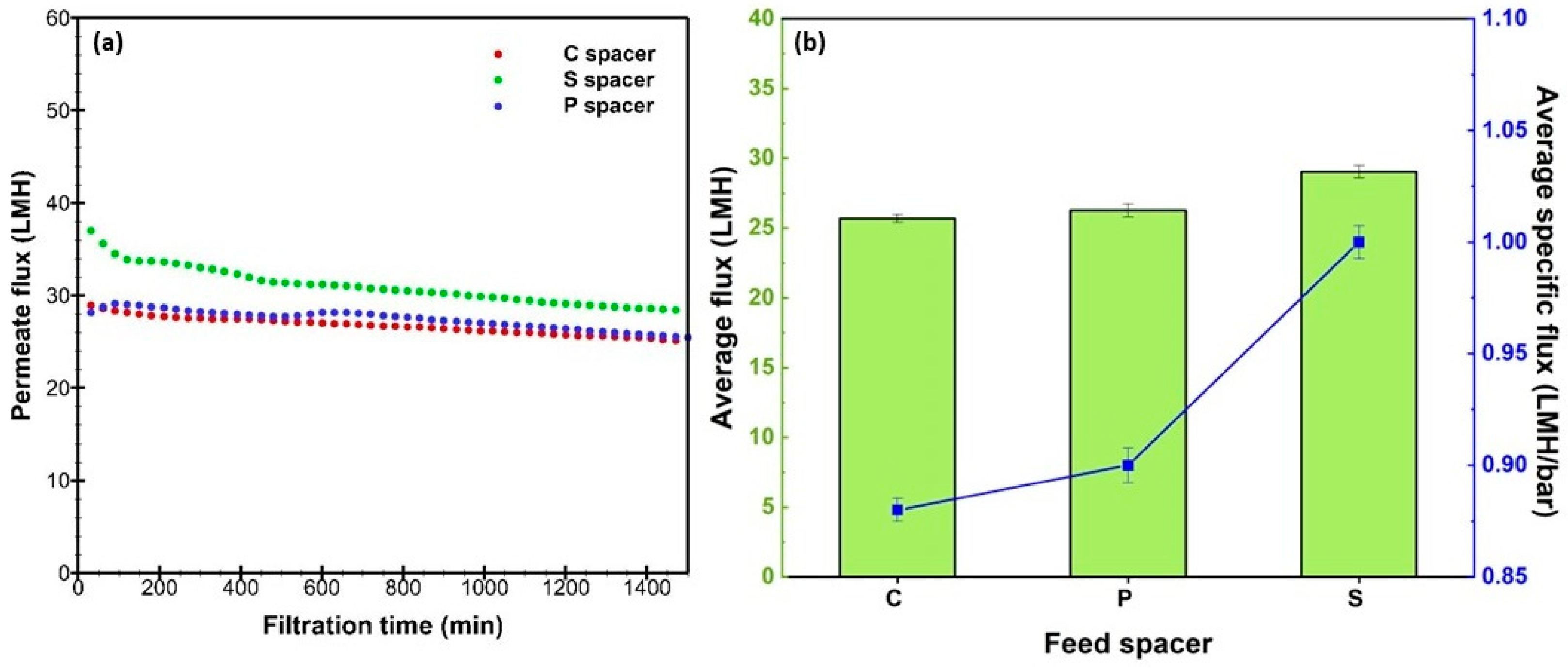
Disclaimer/Publisher’s Note: The statements, opinions and data contained in all publications are solely those of the individual author(s) and contributor(s) and not of MDPI and/or the editor(s). MDPI and/or the editor(s) disclaim responsibility for any injury to people or property resulting from any ideas, methods, instructions or products referred to in the content. |
© 2025 by the authors. Licensee MDPI, Basel, Switzerland. This article is an open access article distributed under the terms and conditions of the Creative Commons Attribution (CC BY) license (https://creativecommons.org/licenses/by/4.0/).
Share and Cite
Kerdi, S.; Qamar, A.; Tanudjaja, H.J.; Ghaffour, N. Spacer Designs for Improved Hydrodynamics and Filtration Efficiency in Sea Water Reverse Osmosis. Membranes 2025, 15, 32. https://doi.org/10.3390/membranes15010032
Kerdi S, Qamar A, Tanudjaja HJ, Ghaffour N. Spacer Designs for Improved Hydrodynamics and Filtration Efficiency in Sea Water Reverse Osmosis. Membranes. 2025; 15(1):32. https://doi.org/10.3390/membranes15010032
Chicago/Turabian StyleKerdi, Sarah, Adnan Qamar, Henry J. Tanudjaja, and Noreddine Ghaffour. 2025. "Spacer Designs for Improved Hydrodynamics and Filtration Efficiency in Sea Water Reverse Osmosis" Membranes 15, no. 1: 32. https://doi.org/10.3390/membranes15010032
APA StyleKerdi, S., Qamar, A., Tanudjaja, H. J., & Ghaffour, N. (2025). Spacer Designs for Improved Hydrodynamics and Filtration Efficiency in Sea Water Reverse Osmosis. Membranes, 15(1), 32. https://doi.org/10.3390/membranes15010032







